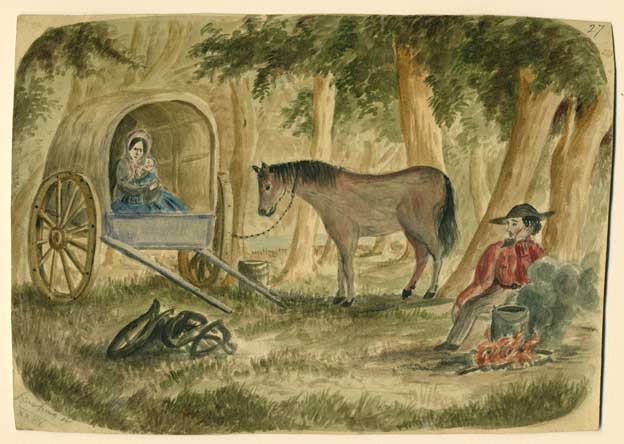Difference between revisions of "Women of Eureka"
Dottigee16 (talk | contribs) |
Dottigee16 (talk | contribs) |
||
| Line 1: | Line 1: | ||
[[File:1996.70 - Doudiet - Camping in the bush2-wiki.jpg|1000px|thumb|right|Charles A. Doudiet, '','' 1850s, pencil on paper. <br>Courtesy Art Gallery of Ballarat, purchased Purchased with funds from the Colin Hicks Caldwell Bequest, 2004.]] | [[File:1996.70 - Doudiet - Camping in the bush2-wiki.jpg|1000px|thumb|right|Charles A. Doudiet, '','' 1850s, pencil on paper. <br>Courtesy Art Gallery of Ballarat, purchased Purchased with funds from the Colin Hicks Caldwell Bequest, 2004.]] | ||
| − | Australian women have been systematically excluded from many narratives of nation building and they have almost disappeared from some historical accounts. The historical record has been mostly silent on the presence of women at Eureka, preferring to focus on the event and notable men, and this has often been taken to indicate that women were ''absent''. Thus the idea of women's invisibility at Eureka has been propagated. | + | Australian women have been systematically excluded from many narratives of nation building and they have almost disappeared from some historical accounts. The historical record has been mostly silent on the presence of women at Eureka, preferring to focus on the event and deeds of notable men, and this has often been taken to indicate that women were ''absent''. Thus the idea of women's invisibility at Eureka has been propagated. |
| − | It was not until Laurel Johnson wrote about the Women of Eureka that they began to stir in our national memory. But still they were not deemed as an important facet in the image of nation building nor did they dovetail with the masculinist image of the rough and tumble goldfields. Corfield, Wickham and Gervasoni included them in The Eureka Encyclopaedia<ref>Corfield, Justin, et al, ''The Eureka Encyclopeadia'', Ballarat Heritage Services, 2004.</ref>in 2004. | + | It was not until Laurel Johnson wrote about the ''Women of Eureka'' that they began to stir in our national memory.<ref>Laurel Johnson, Women of Eureka, Historic Montrose Cottage and Eureka Museum, 1995</ref> But still they were not deemed as an important facet in the image of nation building nor did they dovetail with the masculinist image of the rough and tumble goldfields. Corfield, Wickham and Gervasoni included them in The Eureka Encyclopaedia<ref>Corfield, Justin, et al, ''The Eureka Encyclopeadia'', Ballarat Heritage Services, 2004.</ref>in 2004. |
Given the historical context it is plausible and highly likely that women were active in the protests surrounding Eureka.<ref>Dorothy Wickham. Women in 'Ballarat' 1851-1871: A Case Study in Agency, Volume 2, PhD, School of Behavioural and Social Sciences and Humanities, University of Ballarat, March 2008.</ref> Oral and written testament places women and children not only at the scene of the fracas on 3 December 1854 at the Eureka Stockade on the Eureka Lead but also inside the Eureka Stockade.<ref>Dorothy Wickham. Women in 'Ballarat' 1851-1871: A Case Study in Agency, Volume 2, PhD, School of Behavioural and Social Sciences and Humanities, University of Ballarat, March 2008.</ref> | Given the historical context it is plausible and highly likely that women were active in the protests surrounding Eureka.<ref>Dorothy Wickham. Women in 'Ballarat' 1851-1871: A Case Study in Agency, Volume 2, PhD, School of Behavioural and Social Sciences and Humanities, University of Ballarat, March 2008.</ref> Oral and written testament places women and children not only at the scene of the fracas on 3 December 1854 at the Eureka Stockade on the Eureka Lead but also inside the Eureka Stockade.<ref>Dorothy Wickham. Women in 'Ballarat' 1851-1871: A Case Study in Agency, Volume 2, PhD, School of Behavioural and Social Sciences and Humanities, University of Ballarat, March 2008.</ref> | ||
Revision as of 16:46, 22 November 2013
Australian women have been systematically excluded from many narratives of nation building and they have almost disappeared from some historical accounts. The historical record has been mostly silent on the presence of women at Eureka, preferring to focus on the event and deeds of notable men, and this has often been taken to indicate that women were absent. Thus the idea of women's invisibility at Eureka has been propagated.
It was not until Laurel Johnson wrote about the Women of Eureka that they began to stir in our national memory.[1] But still they were not deemed as an important facet in the image of nation building nor did they dovetail with the masculinist image of the rough and tumble goldfields. Corfield, Wickham and Gervasoni included them in The Eureka Encyclopaedia[2]in 2004.
Given the historical context it is plausible and highly likely that women were active in the protests surrounding Eureka.[3] Oral and written testament places women and children not only at the scene of the fracas on 3 December 1854 at the Eureka Stockade on the Eureka Lead but also inside the Eureka Stockade.[4]
Also See
Elizabeth Abbott; Sarah Hanmer;
References
- ↑ Laurel Johnson, Women of Eureka, Historic Montrose Cottage and Eureka Museum, 1995
- ↑ Corfield, Justin, et al, The Eureka Encyclopeadia, Ballarat Heritage Services, 2004.
- ↑ Dorothy Wickham. Women in 'Ballarat' 1851-1871: A Case Study in Agency, Volume 2, PhD, School of Behavioural and Social Sciences and Humanities, University of Ballarat, March 2008.
- ↑ Dorothy Wickham. Women in 'Ballarat' 1851-1871: A Case Study in Agency, Volume 2, PhD, School of Behavioural and Social Sciences and Humanities, University of Ballarat, March 2008.
